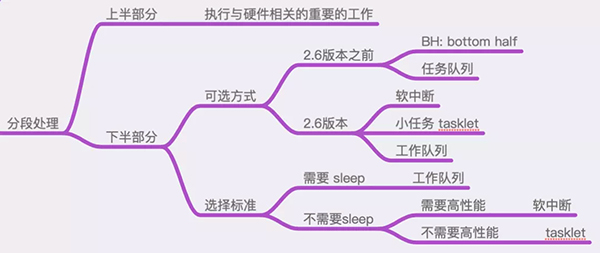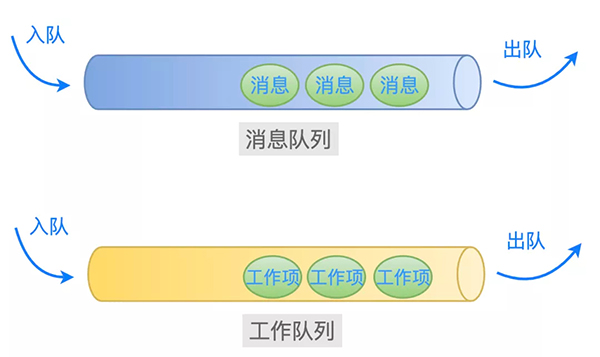- ubuntu12.04环境下使用kvm ioctl接口实现最简单的虚拟机
- Ubuntu 通过无线网络安装Ubuntu Server启动系统后连接无线网络的方法
- 在Ubuntu上搭建网桥的方法
- ubuntu 虚拟机上网方式及相关配置详解
CFSDN坚持开源创造价值,我们致力于搭建一个资源共享平台,让每一个IT人在这里找到属于你的精彩世界.
这篇CFSDN的博客文章Linux 工作队列 workqueue 是什么鬼?由作者收集整理,如果你对这篇文章有兴趣,记得点赞哟.

别人的经验,我们的阶梯! 。
Linux中断处理可用下图总结:

图中描述了中断处理中的下半部分都有哪些机制,以及如何根据实际的业务场景、限制条件来进行选择.
可以看出:这些不同的实现之间,有些是重复的,或者是相互取代的关系.
也正因为此,它们之间的使用方式几乎是大同小异,至少是在API接口函数的使用方式上,从使用这的角度来看,都是非常类似的.
这篇文章,我们就通过实际的代码操作,来演示一下工作队列(workqueue)的使用方式.
工作队列是Linux操作系统中,进行中断下半部分处理的重要方式! 。
从名称上可以猜到:一个工作队列就好像业务层常用的消息队列一样,里面存放着很多的工作项等待着被处理.

工作队列中有两个重要的结构体:工作队列(workqueue_struct) 和 工作项(work_struct):
在内核中,工作队列中的所有工作项,是通过链表串在一起的,并且等待着操作系统中的某个线程挨个取出来处理.
这些线程,可以是由驱动程序通过 kthread_create 创建的线程,也可以是由操作系统预先就创建好的线程.
这里就涉及到一个取舍的问题了.
如果我们的处理函数很简单,那么就没有必要创建一个单独的线程来处理了.
原因有二:
为了避免这种情况,于是操作系统就为我们预先创建好一些工作队列和内核线程.
我们只需要把需要处理的工作项,直接添加到这些预先创建好的工作队列中就可以了,它们就会被相应的内核线程取出来处理.
例如下面这些工作队列,就是内核默认创建的(include/linux/workqueue.h):
以上这些默认工作队列的创建代码是(kernel/workqueue.c):
此外,由于工作队列 system_wq 被使用的频率很高,于是内核就封装了一个简单的函数(schedule_work)给我们使用:
当然了,任何事情有利就有弊! 。
由于内核默认创建的工作队列,是被所有的驱动程序共享的.
如果所有的驱动程序都把等待处理的工作项委托给它们来处理,那么就会导致某个工作队列中过于拥挤.
根据先来后到的原则,工作队列中后加入的工作项,就可能因为前面工作项的处理函数执行的时间太长,从而导致时效性无法保证.
因此,这里存在一个系统平衡的问题.
关于工作队列的基本知识点就介绍到这里,下面来实际操作验证一下.
之前的几篇文章,在驱动程序中测试中断处理的操作流程都是一样的,因此这里就不在操作流程上进行赘述了.
这里直接给出驱动程序的全貌代码,然后查看 dmesg 的输出信息.
创建驱动程序源文件和 Makefile:
示例代码全貌 。
测试场景是:加载驱动模块之后,如果监测到键盘上的ESC键被按下,那么就往内核默认的工作队列system_wq中增加一个工作项,然后观察该工作项对应的处理函数是否被调用.
Makefile 文件 。
编译、测试 。
检查驱动模块是否加载成功:
再看一下 dmesg 的输出信息:
说明:驱动程序的初始化函数 myirq_init 被调用了,并且成功注册了 1 号中断的处理程序.
此时,按一下键盘上的 ESC 键.
操作系统在捕获到键盘中断之后,会依次调用此中断的所有中断处理程序,其中就包括我们注册的 myirq_handler 函数.
在这个函数中,当判断出是ESC按键时,就初始化一个工作项(把结构体 work_struct 类型的变量与一个处理函数绑定起来),然后丢给操作系统预先创建好的工作队列(system_wq)去处理,如下所示:
因此,当相应的内核线程从这个工作队列(system_wq)中取出工作项(mywork)来处理的时候,函数 mywork_handler 就会被调用.
现在来看一下 dmesg 的输出信息:
可以看到:mywork_handler函数被正确调用了.
完美! 。
原文链接:https://mp.weixin.qq.com/s/WDPXOBBAni09UvgV_zxy0g 。
最后此篇关于Linux 工作队列 workqueue 是什么鬼?的文章就讲到这里了,如果你想了解更多关于Linux 工作队列 workqueue 是什么鬼?的内容请搜索CFSDN的文章或继续浏览相关文章,希望大家以后支持我的博客! 。
关闭。这个问题不符合Stack Overflow guidelines .它目前不接受答案。 要求我们推荐或查找工具、库或最喜欢的场外资源的问题对于 Stack Overflow 来说是偏离主题的,
Linux 管道可以缓冲多少数据?这是可配置的吗? 如果管道的两端在同一个进程中,但线程不同,这会有什么不同吗? 请注意:这个“同一个进程,两个线程”的问题是理论上的边栏,真正的问题是关于缓冲的。 最
我找到了here [最后一页] 一种有趣的通过 Linux 启动 Linux 的方法。不幸的是,它只是被提及,我在网上找不到任何有用的链接。那么有人听说过一种避免引导加载程序而使用 Linux 的方法
很难说出这里要问什么。这个问题模棱两可、含糊不清、不完整、过于宽泛或夸夸其谈,无法以目前的形式得到合理的回答。如需帮助澄清此问题以便重新打开,visit the help center . 关闭 1
我试图了解 ld-linux.so 如何在 Linux 上解析对版本化符号的引用。我有以下文件: 测试.c: void f(); int main() { f(); } a.c 和 b.c:
与 RetroPie 的工作原理类似,我可以使用 Linux 应用程序作为我的桌面环境吗?我实际上并不需要像实际桌面和安装应用程序这样的东西。我只需要一种干净简单的方法来在 RaspberryPi 上
关闭。这个问题不符合Stack Overflow guidelines .它目前不接受答案。 这个问题似乎不是关于 a specific programming problem, a softwar
关闭。这个问题是off-topic .它目前不接受答案。 想改进这个问题吗? Update the question所以它是on-topic用于堆栈溢出。 关闭 10 年前。 Improve thi
有什么方法可以覆盖现有的源代码,我应该用 PyQt、PyGTK、Java 等从头开始构建吗? 最佳答案 如果您指的是软件本身而不是它所连接的存储库,那么自定义应用程序的方法就是 fork 项目。据我所
我的情况是:我在一个磁盘上安装了两个 linux。我将第一个安装在/dev/sda1 中,然后在/dev/sda2 中安装第二个然后我运行第一个系统,我写了一个脚本来在第一个系统运行时更新它。
我在 i2c-0 总线上使用地址为 0x3f 的系统监视器设备。该设备在设备树中配置有 pmbus 驱动程序。 问题是,加载 linux 内核时,这个“Sysmon”设备没有供电。因此,当我在总线 0
关闭。这个问题是off-topic .它目前不接受答案。 想改进这个问题吗? Update the question所以它是on-topic用于堆栈溢出。 关闭 11 年前。 Improve thi
我正试图在 linux 模块中分配一大块内存,而 kalloc 做不到。 我知道唯一的方法是使用 alloc_bootmem(unsigned long size) 但我只能从 linux 内核而不是
关闭。这个问题不符合Stack Overflow guidelines .它目前不接受答案。 这个问题似乎不是关于 a specific programming problem, a softwar
我有 .sh 文件来运行应用程序。在该文件中,我想动态设置服务器名称,而不是每次都配置。 我尝试了以下方法,它在 CentOS 中运行良好。 nohup /voip/java/jdk1.8.0_71/
我是在 Linux 上开发嵌入式 C++ 程序的新手。我有我的 Debian 操作系统,我在其中开发和编译了我的 C++ 项目(一个简单的控制台进程)。 我想将我的应用程序放到另一个 Debian 操
关闭。这个问题需要多问focused 。目前不接受答案。 想要改进此问题吗?更新问题,使其仅关注一个问题 editing this post . 已关闭 4 年前。 Improve this ques
我使用4.19.78版本的稳定内核,我想找到带有企鹅二进制数据的C数组。系统启动时显示。我需要在哪里搜索该内容? 我在 include/linux/linux_logo.h 文件中只找到了一些 Log
我知道可以使用 gdb 的服务器模式远程调试代码,我知道可以调试针对另一种架构交叉编译的代码,但是是否可以更进一步,从远程调试 Linux 应用程序OS X 使用 gdbserver? 最佳答案 当然
是否有任何可能的方法来运行在另一个 Linux 上编译的二进制文件?我知道当然最简单的是在另一台机器上重建它,但假设我们唯一能得到的是一个二进制文件,那么这可能与否? (我知道这可能并不容易,但我只是

我是一名优秀的程序员,十分优秀!